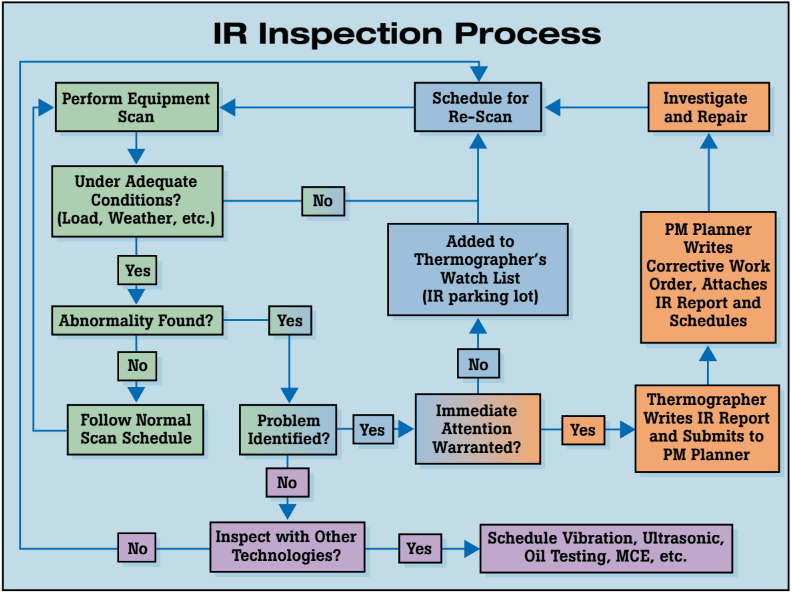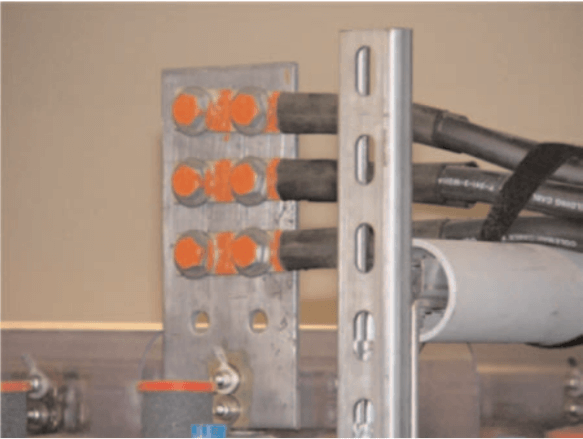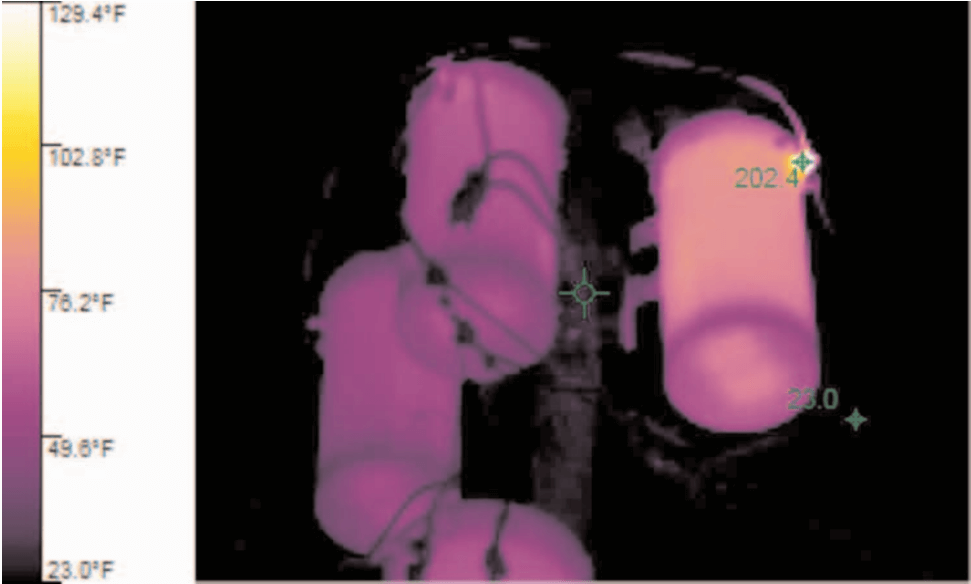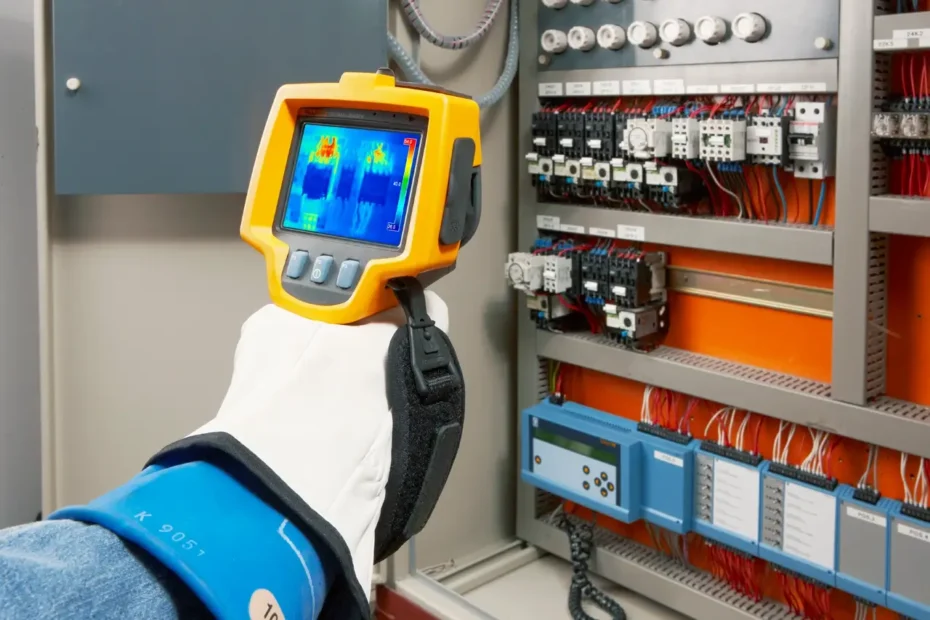Is your facility running too hot?
Heat is often an early symptom of equipment damage or malfunction, making it a key performance parameter monitored in predictive maintenance programs.
Technicians who practice infrared predictive maintenance regularly check the temperature of critical equipment, allowing them to track operating conditions over time and quickly identify unusual readings for further inspection.
By monitoring equipment performance and scheduling maintenance when needed, these facilities reduce the likelihood of unplanned downtime due to equipment failure, spend less on “reactive” maintenance fees and equipment repair costs, extend the lifespan of machine assets, and further maximize maintenance and production.
Here’s the trick: to save money, predictive maintenance should not create excessive additional maintenance efforts. The goal is to transition maintenance resources away from emergency repairs and into scheduled inspections of key equipment. Inspections take less time than repairs, especially if done with a thermal imager.
A thermal imager takes non-contact, infrared temperature measurements that capture an object’s temperature profile as a two-dimensional picture. Unlike an infrared thermometer that only captures temperature at a single point, a thermal imager can capture temperature from both critical components and the entire integrated unit. Thermal imagers can also store previous and current images for comparison and upload images to a central database.
Table of Contents:-
This document discusses the cost savings of thermal imaging (thermography) predictive maintenance, provides guidelines for successfully capturing and analyzing thermographic data and describes how to integrate thermography into a predictive maintenance program.
Cost Savings:
Studies by the Federal Energy Management Program, estimate that a properly functioning predictive maintenance program can provide savings of 30 % to 40 % over reactive maintenance. Other independent surveys indicate that, on average, starting an industrial predictive maintenance program results in the following savings:
- Return on investment: 10 times
- Reduction in maintenance costs: 25 % to 30 %
- Elimination of breakdowns: 70 % to 75 %
- Reduction in downtime: 35 % to 45 %
- Increase in production: 20 % to 25 %
To calculate the savings at your facility, start by estimating the costs of unplanned equipment failures. Factor in human resources, costs for parts, and the lost revenue from specific production lines.
Then, once your thermal maintenance program is up and running, start tracking the savings. Keep a record of machine asset availability, production output, and the distribution of maintenance dollars and total maintenance costs over time. Those numbers will help you calculate the return on your thermal imaging and maintenance investment.
Integrating Infrared Thermography into Predictive Maintenance:-
Infrared thermography cameras are the first line of defense in a predictive maintenance program. Technicians can quickly measure and compare heat signatures for each piece of equipment on the inspection route, without disrupting operations.
If the temperature is markedly different from previous readings, facilities can then use other maintenance technologies — vibration, motor circuit analysis, airborne ultrasound, and lube analysis — to investigate the source of the problem and determine the next course of action.
For best results, integrate all of your maintenance technologies into the same computer system, so that they share the same equipment lists, histories, reports, and work orders. Once the infrared data is correlated with data from other technologies, the actual operating condition of all assets can be reported in an integrated format.

Applications:-
- Monitor and measure bearing temperatures in large motors or other rotating equipment.
- Identify “hot spots” in electronic equipment.
- Identify leaks in sealed vessels.
- Find faulty insulation in process pipes or other insulated processes.
- Find faulty terminations in high-power electrical circuits.
- Locate overloaded circuit breakers in a power panel.
- Identify fuses at or near their current rated capacity.
- Identify problems in electrical switchgear.
- Capture process temperature readings.
Inspection Process:-
- Begin by using existing lists of equipment from a computer-managed maintenance system (CMMS) or another inventory tool.
- Eliminate items that aren’t well suited for infrared measurement.
- Review maintenance and production records. Prioritize key equipment that is prone to failure or often causes production bottlenecks.
- Use a database or spreadsheet to group the critical equipment, either by area or function, into roughly 2-3 hour inspection blocks.
- Use your thermal imager to capture baseline images of each piece of critical equipment. Note: on some pieces of equipment, you may want to regularly capture multiple thermal images of key components or subsystems.
- Download the baseline images into the software and document your route with location descriptions, inspection notes, emissivity and RTC levels and alarm levels if appropriate.
- When the next inspection is due, if your imager supports uploading, simply load the previous inspection images onto the camera and follow the onscreen prompts.
Measurement Guidelines for Infrared Thermography:-
To capture the best thermal images, follow these best practices:
- Verify that the target system is operating at a minimum of 40% of the load (lighter loads don’t produce much heat, making it hard to detect problems).
- Get close to your target and don’t “shoot” through doors, especially not through glass. When safety procedures allow, electrical enclosures must be opened or infrared windows or viewports utilized.
- Account for wind and air currents. These powerful convective forces cool the abnormal hot spots, often below the threshold of detection.
- Account for ambient air temperatures, especially outdoors. In hot weather, the sun can heat the equipment while cold weather can mask the effects of overheating components.
- Not all problems are hot! Blown fuses and restricted flow in cooling systems are just two examples of situations where a problem is indicated by a cooler-than-normal signature. In other cases, a cold component is abnormal due to the current being shunted away from the high-resistance connection. Thermographers must understand how a machine works and what its heat-related failure signatures are.

- Consider sources for reflective infrared radiation. Items that have shiny reflective surfaces and are emissive will reflect infrared energy from other nearby objects, including the sun. This can interfere with target temperature measurement and image capture.
- Unpainted metals are difficult to measure. To improve measurement accuracy and repeatability, consider affixing “targets,” typically paper stickers, electrical tape, or painted spots, to such components.
- Accumulate both numeric temperatures and thermal images, to facilitate long-term data analysis. Temperature trends will show you where to investigate more and where inspections can be less frequent.
- Once you have a database of baseline images, associate an alarm temperature with each one. Upload the most recent version onto your camera before each inspection. If the alarm goes off when you take the new measurement, that indicates a significant change in temperature that needs to be investigated.
Example 1: Motor Bearings :
Start with a newly commissioned and freshly lubricated motor and take a “snapshot” of the motor bearing housing while the motor is running. Use this image as a baseline.
As the motor and its lubrication age, the bearings become worn and heat-producing friction develops in the motor bearing, causing the outside of the bearing housing to heat up. Take additional thermal images at regular intervals, comparing them to the baseline to analyze the motor’s condition.
When the thermal images indicate an overheating bearing, generate a maintenance order to replace or lubricate the bearing housing and reduce or eliminate the possibility of costly engine failure.

Example 2: Spotting leaky Gaskets and Seals:
Finding leaks in sealed vessels is a “snap” when using thermal imagers. Most leaks develop in or around a gasket or seal. Less often, corrosion will cause weakness to develop and rupture the vessel.
Either way, an infrared imager can diagnose the problem. To find a leaky gasket or seal, scan the imager along the seal looking for thermal eccentricities. A large change in temperature along the seal or gasket indicates a loss of either heat or cold — the “signature” of a failure.
Thermal Measurement Safety:-
To keep your thermography inspections accurate, effective and safe, establish written inspection procedures for measurement collection and interpretation. Following the same steps each time assures you have consistent thermal images in your database for comparison.
Sapphire Technologies is an authorized Fluke Distributor in Bangalore, Karnataka. We provide a variety of Infrared thermal imagers to make your Predictive Maintenance easy and cost-effective. Contact us to know which thermal imager would be best fit your facility.
